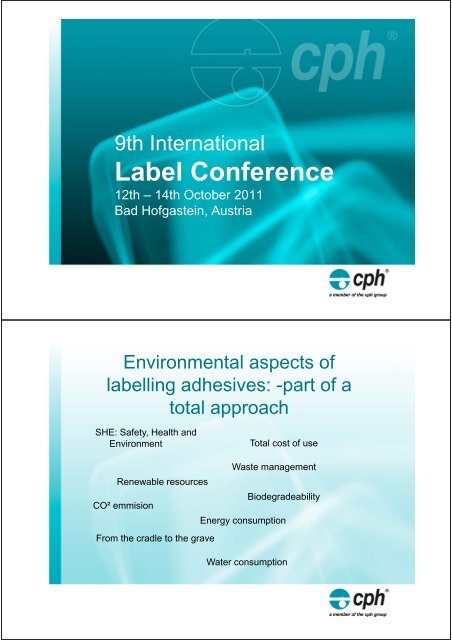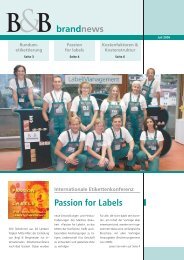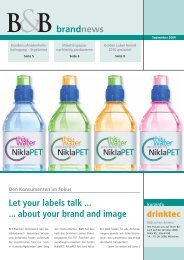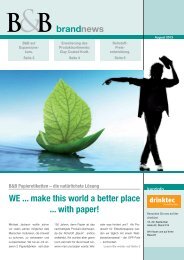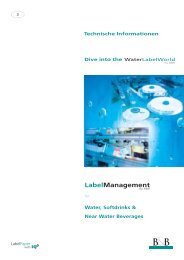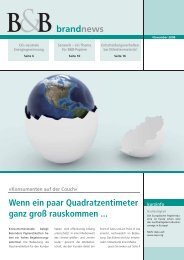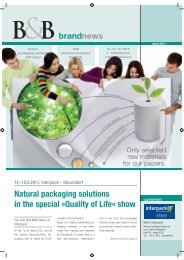Label Conference - Brigl & Bergmeister
Label Conference - Brigl & Bergmeister
Label Conference - Brigl & Bergmeister
Create successful ePaper yourself
Turn your PDF publications into a flip-book with our unique Google optimized e-Paper software.
9th International<br />
<strong>Label</strong> <strong>Conference</strong><br />
12th – 14th October 2011<br />
Bad Hofgastein, Austria<br />
Environmental aspects of<br />
labelling adhesives: -part of a<br />
total approach<br />
SHE: Safety, Health and<br />
Environment<br />
Total cost of use<br />
Waste management<br />
Renewable resources<br />
Biodegradeability<br />
CO² emmision<br />
Energy consumption<br />
From the cradle to the grave<br />
Water consumption
Sustainability<br />
Total cost of use<br />
Adhesive 1 versus Adhesive 2<br />
Price x consumption<br />
Use of NaOH<br />
Use of Water<br />
Use of Energy<br />
Machine cleaning<br />
Use of anti-foaming agent<br />
Use of additives<br />
Productivity<br />
----------------------------<br />
Total cost with Adh 1<br />
Price x consumption<br />
Use of NaOH<br />
Use of Water<br />
Use of Energy<br />
Machine cleaning<br />
Use of anti-foaming agent<br />
Use of additives<br />
Productivity<br />
----------------------------<br />
Total cost with Adh 2
Source: Practical Manual for Cleaning Returnable Glass or Pet bottles<br />
Temp<br />
75 C or 82 C<br />
NaOH<br />
1% or 2,5%<br />
19m2 or<br />
36m2/hour<br />
15.000 or<br />
60.000 bottles/hour
Typical properties/characteristics of<br />
labelling adhesives<br />
Initial Tack<br />
Tack build-up<br />
Setting Time<br />
Time to fibre tear<br />
Viscosity<br />
Shelf life<br />
Solids<br />
pH<br />
Ideal operating temperature<br />
Washability<br />
Condensation-water resistance<br />
Ice-water resistance<br />
Measurable Values<br />
Working values<br />
All the above are properties/characteristics of interest but they do not<br />
depend on the adhesive alone<br />
EU Ecolabel award<br />
1. The objective of the Community eco-label award scheme (hereafter referred to as the<br />
Scheme) is to promote products which have the potential to reduce negative environmental<br />
impacts, as compared with the other products in the same product group, thus contributing to<br />
the efficient use of resources and a high level of environmental protection. This objective shall<br />
be pursued through the provision of guidance and accurate, non-deceptive and scientifically<br />
based information to consumers on such products.<br />
The Community Eco-label award scheme is designed to:<br />
- promote products which have a reduced environmental impact compared with<br />
other products in the same product group.<br />
- provide consumers with accurate and scientifically based information and<br />
guidance on products.<br />
http://europa.eu/legislation_summaries/other/l28020_en.htm
Typical properties of labelling adhesives<br />
Viscosity<br />
Shelf life<br />
Solids<br />
pH<br />
Measurable Values<br />
Initial Tack<br />
Tack build-up<br />
Setting Time<br />
Time to fiber tear<br />
Working Values<br />
Ideal operating temperature<br />
Washability<br />
Condensation-water resistance<br />
Ice-water resistance<br />
All the above are properties of interest but they do not depend on the adhesive alone<br />
Free of Zn and heavy metals<br />
BOD5/COD<br />
SHE values<br />
TMDD-free<br />
Environmental and health-related considerations (e.g. their social aspect)<br />
which can be mentioned<br />
ZnO Legislation<br />
Under new EU legislation Zinc Oxide has been<br />
classified as Dangerous to Environment<br />
(N: R50/53 - Very toxic to aquatic organisms,<br />
may cause long-term adverse effects in the<br />
aquatic environment).<br />
This new legislation means that labels bearing<br />
an environmental warning are now required on<br />
products with a zinc oxide content of 25% and<br />
above.
TMDD<br />
2,4,7,9-Tetramethyl-5-decyne-4,7-diol<br />
H412: Harmful to aquatic life with long lasting effects H 319: Causes serious eye irritation<br />
GHS P statement<br />
P273: Avoid release to the environment P280: Wear protective gloves/protective clothing/eye<br />
protection/face protection P305 + P351 + P338: IF IN EYES: Rinse cautiously with water<br />
for several minutes. Remove contact lenses, if present and easy to do. Continue rinsing<br />
Hazard<br />
XI: Irritant Risk<br />
36: Irritating to eyes. 52/53: Harmful to aquatic organisms, may cause long-term adverse<br />
effects in the aquatic environment. Safety<br />
26: In case of contact with eyes, rinse immediately with plenty of water and seek medical<br />
advice. 39: Wear eye/face protection. 61: Avoid release to the environment. Refer to<br />
special instructions / safety data sheets.<br />
Used as an anti-foaming- and emulsifying agent in the production of adhesives<br />
TMMD<br />
A study carried out at the Spanish University<br />
of Saragosa showed the presence of TMDD<br />
in 50% of adhesives used in the food industry.<br />
As to the possibility of TMMD migrating to<br />
packaged food the European Adhesives<br />
Industry is conducting a project to establish<br />
whether or not such migration occurs.<br />
TMDD is assigned to Toxicity Class III, which<br />
is a very high rating.
GREEN PERFORMANCE<br />
• For packaging applications used for a few days (then thrown away) both the<br />
impact of the product carbon footprint and the recyclability/biodegradability/<br />
biocompostablility aspects can become important.<br />
• Development of biodegradable adhesives based on renewable resources goes<br />
hand-in-hand with the development of biodegradable plastic products in general.<br />
• Possible application: The use of the hydrolysable (water soluble adhesives) for<br />
bottle labels.<br />
• Advantage: Such an adhesive would improve the ability to recycle plastic and<br />
glass bottles by permitting easy removal of the paper labels.<br />
• The adhesive dissolved in the water would then biologically degrade very easily.<br />
**Originally produced for a presentation in Rosenmont, Illinois on 26th/27th July 2011<br />
BOD-5: biochemical oxygen demand<br />
Biochemical oxygen demand or BOD = the amount of oxygen<br />
that bacteria need to biologically oxidise the organic compounds<br />
present in wastewater = « natural degradation ».<br />
BOD-5 = biological oxidation over a 5-day period.<br />
To determine the BOD-5, several dilutions in H ² O (containing<br />
« seed-bacteria ») of a test-sample are analyzed for dissolved<br />
oxygen before and after a 5-day incubation period at 20° C in<br />
the dark.<br />
BOD-5 unit = mg O ² /litre.
COD: chemical oxygen demand<br />
Chemical oxygen demand or COD = the amount of oxygen that is<br />
needed to chemically oxidise the organic compounds present in<br />
wastewater = « chemical degradation ».<br />
The COD test is carried out on waste water and/or test sample<br />
diluted with pure water by adding a mixture of bichromate and<br />
sulphuric acid which chemically oxidises all biologically- and non<br />
biologically degradeable organic materials.<br />
COD unit = mg O ² /litre.<br />
BOD-5/COD ratios in relation to the<br />
biodegradeability of adhesives<br />
• The higher the BOD-5/COD ratio (expresed as a percentage)<br />
the more easily will the material degrade biologically. We<br />
have identified 3 classes of products:<br />
• Readily biodegradeable : BOD-5/COD ratio > 50 %:<br />
includes caseins and starches, altough there is an indication<br />
that starches degrade more slowly.<br />
• Moderately biodegradeable: BOD-5/COD ratio between<br />
40 – 50 %.<br />
• Non-biodegradable : BOD-5/COD ratio < 30 %: typical of a<br />
synthetic-base material.
The comparison of adhesives using<br />
BOD-5/COD ratios expressed as a percentage<br />
Typical properties of labelling adhesives<br />
Viscosity<br />
Shelf life<br />
Solids<br />
pH<br />
Measurable Values<br />
Initial Tack<br />
Tack build-up<br />
Setting Time<br />
Time to fiber tear<br />
Working Values<br />
Ideal operating temperature<br />
Washability<br />
Condensation-water resistance<br />
Ice-water resistance<br />
All the above are properties of interest but they do not depend on the adhesive alone<br />
Free of Zn and heavy metals<br />
BOD5/COD<br />
SHE values<br />
TMDD-free<br />
Environmental and health-related considerations (e.g. their social aspect)<br />
which can be mentioned
SHE<br />
SHE parameters<br />
Contains no heavy metals (no Zn salts added)<br />
Based on 100% renewable resources (proteins and starches)<br />
No NH4 added<br />
No synthetic monomers present<br />
Biodegradability BOD5/COD = 68<br />
APEO free (Alkyl Phenol Ethoxylates)<br />
TMDD free<br />
The raw materials used correspond to the requirements of the FDA Directives 21 CFR 175.105<br />
The preservatives used are without the use of heavy metals , phenols or formaldhyde according to BfR<br />
directives<br />
EU Ecolabel award<br />
1. The objective of the Community eco-label award scheme (hereafter referred to as the<br />
Scheme) is to promote products which have the potential to reduce negative environmental<br />
impacts, as compared with the other products in the same product group, thus contributing to<br />
the efficient use of resources and a high level of environmental protection. This objective shall<br />
be pursued through the provision of guidance and accurate, non-deceptive and scientifically<br />
based information to consumers on such products.<br />
The Community Eco-label award scheme is designed to:<br />
- promote products which have a reduced environmental impact compared with<br />
other products in the same product group.<br />
- provide consumers with accurate and scientifically based information and<br />
guidance on products.<br />
http://europa.eu/legislation_summaries/other/l28020_en.htm
A member of the cph group<br />
Technical Information<br />
Ecocoll 2011<br />
Type of Adhesive<br />
<strong>Label</strong>ling adhesive based on casein/protein<br />
Area of Application<br />
The product is suitable for applying labels to normal - and lightly - coated glass<br />
surfaces, e.g. in the beverage-, food- and pharmaceutical industries etc. The product<br />
has a very high resistance to condensate water and has a high initial tack, can be<br />
easily removed in a automatic bottle washing machine under normal industrial<br />
conditions. Product can be used at low temperatures on high speed machines. It has a<br />
very high mileage with low coating weigth. Suitable for foiling as well as for heavy metal<br />
labeling<br />
Technical Data<br />
Viscosity<br />
(Brookfield RVT, 7/20/25)<br />
Solid Content<br />
(Abbe-Refractometer, 25 °C)<br />
pH-Value<br />
Colour<br />
Odour<br />
Film Properties<br />
70,000 ± 15,000 mPas<br />
44.0 ± 0.5 %<br />
7.3 ± 0.3<br />
Beige-transparent<br />
Product-specific<br />
Firm but elastic<br />
Processing<br />
The temperature processing range is 15 - 32 °C, ideal at approx. 28 °C. Before a<br />
different adhesive is to be used on the machine, it must be carefully cleaned.<br />
Cleaning<br />
Storage<br />
Packaging<br />
SHE parameters<br />
The product can be removed by washing with water but dried film needs warm water. If<br />
necessary, adhesive residues can be removed carefully with a scraper.<br />
The product can be stored in its original sealed container for at least six months at room<br />
temperature after date of production - but not below +4 °C.<br />
33 kg per pail - 18 pails per pallet; 700 kg and 1,000 kg container<br />
Heavy Metal free (no Zn salts added)<br />
Based on 100% renewable resources (proteins and starches)<br />
No NH4 added<br />
No synthetic monomers present<br />
Biodegradability BOD5/COD = 68<br />
APEO free (Alkyl Phenol Ethoxylates)<br />
TMMD free<br />
The raw materials used correspond to the requirements of the FDA Directives 21 CFR 175.105<br />
The preservatives used are without the use of heavy metals , phenols or<br />
formaldhyde according to BfR directives<br />
Legal Considerations To the best of our knowledge and experience, the data / information we have provided is<br />
reliable but it does not amount to a statement of assured properties in the context of the<br />
latest regulations issued by the Federal Court of Justice. With regard to the many<br />
options available in terms of alternative applications and operating conditions the data /<br />
information can only be regarded as of a non-binding nature. In each separate case it is<br />
necessary for you to carry out your own trials before large-scale use although, of<br />
course, in that respect our application technology is available to you upon request.<br />
Version: May 2010/Protac 1460_eti_Rev04_03052010.xl<br />
cph Deutschland Chemie Produktions-<br />
Certified according to ISO 9001 and<br />
ISO 14001<br />
Heinz-Bäcker-Str. 33<br />
service@cph-group.com<br />
D-45356 Essen<br />
Fon: +49 (0) 201 - 81 40 6 - 0<br />
w w w .cph-group.com<br />
Fax: +49 (0) 201 - 81 40 6 -25<br />
Product data
Green adhesives<br />
Statement:<br />
A&S are green by action – not by content<br />
<br />
Our statement<br />
Adhesives for the labeling and packaging industry<br />
should also be more green by impact and content.
Thanks for your attention!


